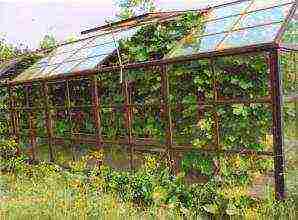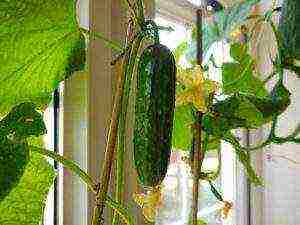Content [show]
The north window is considered among florists unsuitable for growing indoor plants, especially flowering ones. Is it really?
North-facing windows are not illuminated by the sun. Or they are illuminated for 1-2 hours if they face northwest or northeast. The light on the windowsills is only diffused. It is believed that this is not enough to grow most indoor plants. From a lack of light, their stems stretch out, the color of the leaves becomes pale, and flowering never occurs.
On the forums, many lovers of home plants write that deciduous begonias, shade-loving ferns, and many plants of the aroid family grow well on the northern windows. Despite the lack of light, fuchsias, cyclamens and violets bloom.
What is the contradiction? Why are some northern windows not suitable for flowers, while others are a great place for plants?
North Windows Properties
The most important characteristic of a window is illumination. It can be measured with a luxmeter. The second important feature is temperature.
Illumination of the window. If it is not possible to measure the illumination, it can be estimated approximately. Look at the window of your apartment and answer the following questions:
Is it large or small in terms of glass area?
Are there double-glazed windows or old double frames that are difficult to open and the glass is rarely cleaned?
Are trees growing outside the window, are buildings close by?
Where do you live, in the south or north, in Murmansk or Tashkent?
If the north window is large, in the southern edges, where the intensity of sunlight is high, and high-quality double-glazed windows are installed in it, then such a window is perfect for indoor plants. If the window is small, on the ground floor, a tree grows in front of the window - only the most hardy plants, chlorophytum or sansevier, for example, can be placed here.
Temperature... The temperature at the window can differ significantly from the temperature in the room. This characteristic is more important for the southern windows - on them, indoor flowers in the summer simply overheat, boil, and die from this. The north window can be slightly colder in winter than in the room - cold air enters through the cracks, and the sun does not heat the windowsill. But in summer, the temperature is stable and it's just great for the plants.
Northern windows and seasons
In spring and summer daylight hours are long. Even if the sun never looks through the window, the illumination by reflected and diffused sunlight is quite high. At the same time, many indoor plants have to be removed from the southern windows - they cannot withstand the summer sun. In summer, you can move ficuses to the north window, especially small-leaved ones, for example, Benjamin's ficus. Schefflera, dracaena, cordilina, arrowroot and many other indoor plants in summer will feel better on the north window.
If there is a balcony that faces north, then this spot is just great for most houseplants in the summer. Petunias and pelargoniums will bloom on it, you can put a date palm and anthuriums there.
In winter and on gloomy autumn days, many tropical indoor plants suffer from a lack of light in the south window.What can we say about the north! The backlight will solve the problem. Several fluorescent lights will prolong the winter day and will be beneficial for the plants.
What indoor plants are suitable for northern windows
First of all, violets blooming on the northern window can live, fuchsias feel good, cyclamen and spathiphyllum will bloom. Amaryllids can be an excellent choice for the northern window: hippeastrum, clivia, zephyranthes, if you know one secret. These plants do not require a lot of sun in order to release flower stalks, and the flower buds in the bulbs are laid in the summer, when there is more light and the plants can be taken out to the balcony. In summer, hippeastrum can be kept on the balcony or even in the garden, in winter they go through a period of dormancy (if there are no leaves, then not even on the window), and when a peduncle appears, a beautiful flower will also delight the north window!
For deciduous plants, ferns can be kept in the north window. Almost all of them are shade-loving plants, found naturally in forests. The maidenhair (hair venus), nephrolepis looks very decorative. Without any problems, you can grow zamioculcas and unpretentious plants - chlorophytums or sansevieria (mother-in-law's tongue). It does not suffer at all in the shade of aspidistra; it can grow at some distance from the window.
Deciduous begonias are also a good choice for a north-facing window. Dieffenbachia, alocasia, syngonium - plants from the Aroid family - can also grow on a large window. Anthurium will not disappear either, but most likely it will not bloom. The same can be said about Aeschinanthus - its long lush stems will delight with greenery, but not flowers.
Even palms can be grown on the north window, although they are considered light-loving plants. The chamedorea bamboo palm grows well in shaded areas and is great for windows without direct sunlight.
Hibiscus (Chinese rose) can be grown from large plants. This plant perfectly adapts to different conditions and also tolerates shade well.
From climbing plants, shade-loving ivy, hoya and cissus (indoor grapes) are suitable for northern rooms. It is better to choose ivy green, variegated varieties lose their bright color in low light.
The choice of indoor plants for the northern window is large, you can always pick up flowers that will give you a good mood and will not require any special worries.
In rooms with northern windows, shade-tolerant and shade-loving plants will feel good. If the windows are small, then the flowers can be placed close to the glass, since the direct sunlight almost does not look into such rooms. The colors that rooms with northern windows suit best in the world are few.
indoor plants for northern windows
If in a room with northern windows the heating is good and in winter it does not drop below 18 °, then thermophilic species, that is, inhabitants of the tropics and humid subtropics, will feel good in it. But in such rooms, you should not grow those plants that need a dormant period in winter, since this requires a lower temperature. And even in such rooms (warm northern ones), light-loving plants will grow poorly without additional illumination.
flowers for warm northern windows
dichorizandra (golden mustache) - homeland of the tropics of America. Tradescantia and golden mustache are close relatives. Dichorizander is an ampelous medicinal plant, leaves are rather large, lanceolate, inflorescences are brush with flowers up to 1.5 cm in diameter, blue in color. An unpretentious enough plant for a novice florist. It becomes medicinal when more than nine internodes are formed on the shoot.
- Humidity requirements: moisture-loving, watered abundantly in summer, moderately in winter.
- Temperature: thermophilic.
- Light: does not like direct sunlight.
- Soil and nutrition: if you find a mixture "For tradescantia" in the store, then it will be an ideal option, a universal soil mixture for decorative deciduous species is also suitable.
- Reproduction: propagated by cuttings, which are rooted in the sand.
- Peculiarities: likes to sit in small pots, in which she grows more actively.
irezina (irezine)- homeland, mainly in the tropics of Brazil, an ornamental deciduous shrub from the amaranth family.
Irezina Lindena (achirantes, strawflower)- a dwarf shrub with fleshy, thick stems and opposite leaves pointed at the top. The color of the leaves is purple, the flowers are inconspicuous.
Irezina Herbst- a small shrub with interesting leaves. They have a wide-oval shape and a notch at the top of the leaf, this makes the leaves look like hooves. Leaves and shoots are dark purple with red veins. There is a variety of golden mesh with leaves and shoots of light green color and golden veins. The Wallis variety has smaller, reddish-brown leaves. The plant is relatively unpretentious.
- Moisture requirement: watering should be moderate, but frequent, so that the soil is always moist. If the plant is in a highly consecrated place, then water more abundantly. In the summer, in the heat, you need to spray regularly.
- Temperature: the most optimal - 18-22 °, can withstand a short decrease, but if only this decrease was not sharp. Afraid of drafts.
- Light: irezine prefers diffused light, but irezine Linden is a shade-tolerant plant, and Herbst turns pale with strong shading.
- Soil and nutrition: undemanding to soil and nutrition. Soils are suitable for any universal, nutrition during the period of active growth is not too frequent, organic (once a month or less). Do not overfeed with nitrogen, otherwise the leaves will not be so intensely colored, and it is in them that the beauty of this shrub is.
- Reproduction: irezin cuttings. Semi-lignified, green on top cuttings in August-September are better suited, you can use the apical cuttings remaining after pruning.
- Peculiarities: in order for the bush to grow fluffy and beautiful, the plant needs to be cut or pinched in the fall. Remove flowers constantly as they appear. It is better to transplant less often, only when it becomes completely cramped in the pot. Before frost can be on the balcony.
Cryptantus -decorative leafy plant from the bromeliad family. Among bromeliads, this is probably the most unpretentious plant, but this is only among bromeliads, but in general its unpretentiousness is relative.
This is a low-growing plant with lanceolate-lily leaves collected in rosettes, which are wavy, fine-toothed along the edge, from 8 cm to 25 cm long. The leaves are green, purple with various longitudinal stripes.
- Moisture requirement- moderate watering is needed and bromeliads like to have a little water accumulate in the leaf outlet. Does not tolerate completely drying out of the soil and requires increased atmospheric humidity for comfortable growth.
- Climatic conditions: tropics of America.
- Temperature: in winter, the optimum is 18 ° -20 °, but will tolerate a decrease to 15 °.
- Light: a shade-loving plant that grows precisely on the northern windows, on others you will have to shade.
- Soil and Nutrition: soil "For orchids and bromeliads", "Orchid" and similar. In the summer they are fed with organic fertilizers.
- Reproduction: offspring are formed in the axils of the leaves, so they are propagated by them.
- Peculiarities: can be used in compositions with succulents, only you need to water so that the water falls on the cryptantus and remains in it in the leaf axils.
- Leaving (minimal, without which, well, nothing): watering 2 times a week, an additional source of humidity in the atmosphere, located next to the flower. Instead of regular dressing, dry fertilizers (sticks).
Oplismenus (Ostyanka) -decorative deciduous, ampelous. Ostyanka has creeping rooting shoots.It resembles Tradescantia, but the leaves are longer than that of Tradescantia, up to 10 cm. Leaves are green and variegated, and the stripes can be white and pink.
- Climatic conditions: subtropics of Australia and New Zealand.
- Moisture requirement: moderate watering, the soil is moist, but not damp and not wet.
- Temperature: the best temperature in winter is from 17 ° to 22 ° C, but can tolerate a decrease of up to 7 ° C.
- Light: endures both shadow and diffused light.
- Soil and Nutrition: universal earthen mixtures are suitable, feed only when there are signs of a lack of nutrients. The fact is that if you overfeed the plant, then the variegated forms will lose their color.
- Reproduction: parts of the shoot and apical cuttings. The material must have at least two leaves.
- Peculiarities: it is advisable to replant annually, otherwise it loses its decorative effect.
Ruellia- ornamental flowering ampelous plant of the acanthus family. Warm northern rooms are suitable for only one type of ruelle -ruelia formoskaya... Old shoots become ampelous in her, and young ones are erect. Leaves are dark green, pointed at the ends, pubescent. The flowers are bluish-purple, about 4 cm in diameter, funnel-shaped.
If the conditions are right, ruelia can bloom for almost a year.
- Climatic conditions: Ruella is native to the humid tropics.
- Moisture requirements: irrigation is uniform and moderate, in winter it is watered less often. Spraying or something else is used to increase the atmospheric humidity.
- Temperature: in winter from 18 ° to 24 ° С.
- Light: shade-tolerant, bright light is harmful, can be placed both on the window and at a distance from it.
- Soil and nutrition: Jasmine earth or similar, any loose nutrient mix may be used. In spring and summer, every 10 days of organic feeding.
- Reproduction: propagated by cuttings taken from the tops of the shoots and rooted in the sand.
- Peculiarities: if the plant is overcooled or the atmospheric humidity is lower than necessary, then the color of the leaves may fade.
Ficus -decorative and deciduous plant of the mulberry family. Different types of ficus have different requirements. There are several types that are suitable for warm northern rooms:
oak-leaved ficus - a shrub that grows up to 1.5 meters in natural conditions, branches are climbing and outstretched. The leaves are about 5-6 cm and look like oak leaves. In comparison with other ficuses, it is more thermophilic.
Ficus lyre- an evergreen tree, in natural conditions it reaches a height of 12 meters. The leaves are very large, 30 cm wide and up to 60 cm long, leathery, wavy at the edges, shape reminiscent of a lyre, dark green with whitish veins. The rest period is not pronounced.
Ficus sacred- a tree-like plant that forms support roots in the lower part of the trunk. Leaves up to 20 cm long are heart-shaped, bluish-green, at the end of the leaf plate there is a "drop tip". With its help, the plant gets rid of excess moisture. Heat-loving. This type of ficus is poorly propagated by cuttings.
- Climatic conditions: tropics and subtropics.
- Moisture: moderate watering in summer, rare in winter. It can shed leaves if there is an excess of moisture during the dormant period, but the same will happen if the soil is excessively dry during active vegetation. The atmospheric humidity does not bother them, but in the summer you need to wash the leaves from dust.
- Temperature range: during rest does not require a decrease in temperature.
- Light: moderate lighting.
- Soil and nutrition: “For mulberry” soil and good drainage. In active growth periods, you need to feed organic matter every 10 days.
- Reproduction: stem and leaf (with a heel) cuttings, for species that are poorly cuttings, treatment with auxins is needed.
- Peculiarities: in spring, careful pruning, sprinkle the cuts with charcoal powder. Annual transplants.
Chlorophytum- an ornamental deciduous herb from the lily family, with long leaves and daughter rosettes that grow at the end of the peduncle. Thanks to these rosettes, chlorophytum can be grown as an ampelous plant. Leaves are green or with white longitudinal stripes. A very unpretentious plant.
- Climatic conditions: tropics and subtropics.
- Moisture:abundant uniform watering in summer and moderate in winter. During the period of active growth, spraying and washing of the leaves is desirable.
- Temperature: Chlorophytum can tolerate temperatures up to 7 ° C, but it is still better if it is 15 ° -18 ° C.
- Light: the illumination is moderate; in the bright sun, the stripes on the leaves disappear in variegated species.
- Soil and Nutrition: undemanding to either soil or nutrition.
- Reproduction: seeds and offspring.
- Peculiarities: annual transplants.
flowers for cold north windows
If the heating in the room is poor, then these are the necessary conditions for plants with a pronounced dormant period. Shade tolerance and a pronounced dormant period are those characteristics that are typical for plants in dry subtropics. Light-loving plants from the cool subtropics can be placed in rooms with large windows.
Araucaria- evergreen coniferous, araucariaceae family. Araucaria looks like a Christmas tree, needles up to 2 cm long, light green.
- Watering: moderate in summer, economical in winter, excess moisture is harmful.
- Temperature: temperature not higher than 13-15 ° С in winter.
- Soil and nutrition: soil "For araucaria" or similar in composition. You can use, for example, "Cypress". Good drainage and a loose substrate are required.
- Reproduction: seeds and cuttings in July-August. Apical cuttings are taken. Cut the stalk so that the cut is one finger below the green part. For better rooting, phytohormones are used.
- Peculiarities: Do not place the plant close to a wall or glass so that the crown develops symmetrically. Can be used instead of a Christmas tree for the New Year.
Aspidistra (friendly family)Is a deciduous plant of the lily family. Very resistant to adverse factors plant, ideal for beginner growers and dark rooms.
The leaves are large, up to 50 cm long, leathery, broadly lanceolate, dark green, variegated and with white or yellow stripes.
- Climatic conditions: subtropics of China and Japan.
- Watering: Water moderately throughout the year in all respects. That is, both in frequency and in volume.
- Temperature: unpretentious in terms of temperature, withstands drops to 10 ° C.
- Light: a very shade-tolerant plant, and the sun's rays can even cause burns on the leaves.
- Soil and nutrition: any universal earthen mixture is suitable, you can even use garden soil without harm to the plant, you just need to disinfect in any way you know. Fertilize only when signs of nutrient deficiency appear. In case of an overdose of top dressing, variegated forms can lose their color.
- Reproduction: seeds and dividing the bush.
- Peculiarities: he loves the tightness of the pot, he likes that there are many rosettes of leaves in one pot, therefore the name is “Friendly family”.
Aucuba- ornamental deciduous shrub of the cornel family. The plant is dioecious, that is, there are female and male plants. Like all decorative deciduous, the aucuba has inconspicuous flowers, but the berries are decorative, they look like dogwood fruits and are formed on female plants only if there was a blooming male specimen nearby during flowering. The pollen from the male flower needs to be transferred to the female flower with a brush, otherwise pollination cannot occur, because there are no insects or wind in the apartment.
As indoor plants in apartments, the following species are most often cultivated:
aucuba himalayan - in natural conditions this shrub reaches a height of 3 meters, in rooms without pruning - 2.5 m.The leaves are pointed, sometimes toothed, oblong-lanceolate, dark green, orange-red berries.
Aukuba Japanese - it is also called "sausage tree", similar to the Himalayan, but the leaves are ovoid or elongated-oval and they have golden spots of various shapes.
The following varieties are often found:
Goldiana - her leaves are almost yellow.
Long-leaved - the bush is shaped like a weeping willow and the leaf is narrower.
Croton-leaved - in addition to yellow, there are also white spots.
Serrate-leaved - the leaves are elongated, there are denticles at the edges.
Painted - the middle of the sheet is yellow, the edge is dark green.
Sulfurous - the leaves have a wide yellow border around the edge.
Aukuba can be considered an unpretentious plant.
- Climatic conditions: humid subtropics.
- Watering: in spring and summer they are watered rarely, but abundantly, and in winter - rarely and in moderation. Aucuba is hygrophilous, but can tolerate drought. Exactly endure, because this can damage the decorative effect.
- Temperature: all year round, she needs coolness, that is, from 14 ° to 18 °, and in winter, and not at all higher than 13 ° C. From the heat, the leaves grow old and fall off.
- Light: not capricious in this regard, will endure quite serious shading.
- Soil and Nutrition: any loose soil mixture, in the spring and summer, once every 10 days, organic fertilizing.
- Reproduction: stem and apical cuttings in spring and summer.
- Peculiarities: you need to shape the crown by trimming and pinching (pinching). Transplant every 2-3 years, transplant very carefully, without damaging the roots.
Hydrangea (hydrangea)- an ornamental flowering plant from the hydrangea or hydrangia family. Indoor species is large-leaved hydrangea. It has heart-shaped leaves with pointed tips of light green color. Very decorative sepals of pink, blue, lettuce color surround nondescript flowers, and these sepals are mistaken for flowers. Hydrangea is a very hardy plant.
- Climatic conditions: original forms native to the subtropics of Japan.
- Moisture: loves moisture very much, water abundantly in spring and summer. Spray in extreme heat. But despite its moisture-loving nature, it is a rather drought-resistant plant. They say that even a completely dried flower, when completely immersed in water for a while, can come to life, then it needs to be watered abundantly for several days.
- Temperature: in the fall, after the hydrangea has shed its leaves, it must be kept from 7 ° to 13 °.
- Light: not picky about light. Only direct sunlight does not tolerate, and at rest hydrangeas need a thick shade.
- Soil and Nutrition: prefers acidic soils, many soil mixtures with a pH of 4.0-5.0 are suitable. Problems can be with iron deficiency and excess calcium. When the buds appear, it is good to feed with mineral fertilizers. If new shoots have ceased to appear, then this is the first sign of soil depletion.
- Reproduction: rarely seeds, mainly cuttings, offshoots, dividing the bush, layering.
- Peculiarities: If necessary, each flowering shoot should be tied to a peg or rod. Since the plant tolerates high temperatures more easily in the open air, in the summer it can be taken out into the open ground in a shady place or on a balcony. Spray the potted soil with a weak fungicide solution once a year, because hydrangeas are often affected by fungal diseases.
Deergenia - ornamental deciduous shrub from the amaranth family. As a houseplant, the berry-bearing deergenia species is cultivated. It has thin branches on which there are long, oval green leaves, pointed at the top. They come with a white border on the leaves. After greenish-pale flowers, collected in spike-shaped inflorescences, decorative fruits are formed - red berries.
- Climatic conditions: subtropics of Australia.
- Moisture: water in moderation, both in frequency and volume. Water less often in winter.
- Temperature: unpretentious plant in this regard.
- Soil and Nutrition:grows remarkably in a soil mixture of this composition: turf, leaf, peat, sand in a ratio of 2: 1: 1: 1.
- Multiply cuttings.
- Peculiarities: with appropriate support, it can be grown like a liana.
Butcher- ornamental deciduous plant from the lily family, rhizome perennial.
Butcher's broom- has rigid stems with lateral leaf-like shoots, which have an oval or leaf-like shape, with a pointed end. In the axils of scaly bracts, inconspicuous flowers are formed.
Butcher's leaf- in this butcher's broom, flowers are formed on the back of leaf-like shoots.
Buttock sublingual- its shoots are oblong-lanceolate, bracts are white.
These plants are not just unpretentious - they are ascetics in terms of ecological and climatic conditions.
- Climatic conditions: mountainous regions of the Mediterranean, etc.
- Moisture: the plant is drought-resistant, tolerates dry air well, but it still needs to be watered. Moderate watering is desirable both in frequency and volume.
- Temperature: in winter, 13 ° C is enough for it, preferably not higher.
- Light: shade-tolerant, can exist for a long time with severe shading.
- Soil and Nutrition: universal soil mixture.
- Breeds cuttings.
- Peculiarities: to make the plant look decorative, it needs to be pruned.
Cypress- an evergreen tree from the cypress family.
- Moisture: water moderately in summer, economy watering in winter. Excess moisture is harmful to cypress.
- Temperature: in winter not higher than 13º-15ºС.
- Soil and nutrition: soil "Cypress" or similar soil mixtures for conifers.
- Reproduction: seeds. For the cuttings to take root successfully, phytohormones must be used. You need to cut the cuttings one finger below the green part.
- Light:- shade-tolerant.
Cypress outwardly similar to cypress, both belong to the cypress family. The care for them is the same. As an indoor culture, pea cypress and only young immature plants are grown.
Cryptomeria- decorative deciduous tree of the thixodiaceae family.
More often, Japanese cryptomeria is grown in rooms.
- Watering: in summer - moderate, in winter - economical.
- Temperature: in winter not higher than 13 ° -15 ° С.
- Light: shade tolerant.
- Soil and Nutrition: soil mixtures "For araucaria", "Cypress", similar.
- Reproduction: seeds and partially lignified shoots in July-August.
Myrtle -in indoor conditions, an ornamental deciduous shrub, in natural conditions it is a tree up to 3 meters high. In the rooms, common myrtle is cultivated with leaves up to 5 cm long, located opposite and are either oblong-ovate with a point at the end, or lanceolate, leathery, shiny, dark green, fragrant. There are even variegated forms. Myrtle flowers are single, up to 2 cm in diameter, white with a yellowish or reddish tint, fragrant.
- Climatic conditions: subtropics of southern Europe, Africa and the Azores.
- Moisture: in the summer to water abundantly, in the winter - watering-economy.
- Temperature:in winter not higher than 13 ° С.
- Light: loves good lighting, but will tolerate shade.
- Soil and nutrition: the best option is a mixture of turf, deciduous, peat, sand. The ratio is 4: 2: 1: 1, respectively. In the summer, fertilizing with mineral fertilizers.
- Reproduction: seeds and cuttings in spring and summer.
- Peculiarities: if you apply pruning and pinching, you can give the crown a different shape. In spring and summer, it is better to keep it outdoors, for example on a balcony.
Nerine (nymph flower) -an ornamental flowering plant from the amaryllis family.
In apartments, Bowden's nerine is usually grown, which has a peduncle about half a meter long, an umbrella-shaped inflorescence, an inflorescence diameter of up to 25 cm, lily-like flowers, pale pink, blooms in mid-September to mid-November. During the dormant period, which is clearly expressed in this plant, the aerial part almost always completely dies off.
- Climatic conditions: mountains of South Africa.
- Moisture: watering is moderate, and during the dormant period they are not watered at all. So that the bulbs do not disappear, it is enough to moisten the earthen lump once a month.
- Temperature: during rest, keep the pot with the bulb at a temperature of 8 ° -10 ° C.
- Light: in this respect it is not a capricious plant.
- Soil and Nutrition: a mixture of sod and humus soil and sand in a ratio of 3: 3: 1.
- Reproduction: baby bulbs, which, when planting, are not completely embedded in the ground.
- Peculiarities: frequent transplants are undesirable, in summer you can take it out into fresh air, for example, on a balcony. Flowers can even be used for cutting.
Pachisandra- ground cover or ampel plant from the boxwood family.
In the rooms, you can usually see the creeping dwarf shrub pachisandra apical. This plant has bare, fleshy stems, rhombic or elongated rhombic leaves, and inconspicuous flowers, collected in apical, spike-shaped inflorescences.
- Climatic conditions: subtropics of China and Japan.
- Moisture: watering in frequency and volume is moderate, water less often in winter.
- Temperature: in winter not higher than 13 ° С.
- Light: pachisandra is shade-loving, direct sunlight is not for her.
- Soil and Nutrition: the universal dredge is suitable.
- Reproduction: cuttings.
- Peculiarities: looks nice in groups of plants as a ground cover; can be planted in low, wide containers.
Pepper- an ornamental leafy plant of the pepper family.
In indoor conditions, lipoliferous pepper is more often cultivated. In nature, it is a shrub up to 2 meters high. The length of the leaf is up to 20 cm and is similar to a linden leaf. Nondescript flowers are collected in spike-shaped, drooping inflorescences. Lipoliferous pepper is very unpretentious to care for.
- Climatic conditions: tropics.
- Moisture: watering is moderate, spraying in the heat.
- Temperature: unpretentious, behaves normally in the range from 13 ° С to 24 ° С.
- Light: and light and shadow.
- Soil and nutrition: ideal for pepper will be a soil mixture "For piperomia", but in general the best option is a universal soil mixture.
- Reproduction: semi-lignified cuttings.
- Peculiarities: transplants are not often, once every 2-3 years, but pruning and pinching is required.
On sale there are often types of decorated peppers, it has leaves with pronounced silvery veins and saffron pepper, wrinkled leaves with a wax coating and pink veins. So these species are very demanding to care for.
garnished pepper saffron pepper
saffron pepper
Ruellia -an ornamental flowering plant from the acanthus family. In the cold northern rooms, two types of ruelles feel good.
Ruelle Deveaux. A semi-shrub with ampelous shoots, oval leaves 5-6 cm long, dark green above with white pubescent veins, purple below. Flowers up to 5 cm long, growing singly, white with purple stripes.
Ruelle is nice. From ruelia, Deveaux is distinguished by large, monochromatic green leaves. And the flowers are not single, but are collected in paniculate inflorescences, small, reddish.
If good conditions are created for ruelia, they can bloom almost all year round.
- Climatic conditions: humid tropics.
- Moisture: moderate watering. Spraying or other method of increasing atmospheric humidity.
- Temperature: the optimum temperature will be from 13 ° to 18 °.
- Light: all ruelles are not only shade-tolerant, but direct light is contraindicated for them, they can grow not only on the window, but also at a distance from it.
- Soil and Nutrition: a universal mixture for decorative flowering plants is suitable, in spring and summer, once every 10 days, organic feeding.
- Reproduction: by cuttings of the apical shoots, which are rooted in the sand. Ruelia Devaux can also reproduce by layering, which, with a sufficient width of the dishes, can take root in the nodes when it comes into contact with the soil.
- Peculiarities: with insufficient atmospheric humidity and hypothermia, the color of the leaves may fade.
ruella makoya
On sale sometimes
Ruellia Makoya,
she looks like Deveaux's ruella, but the flowers are not
ruella grandiflorum
white and dark pink. And the large-flowered ruelia, in which the leaves are pleasant, but the flowers are much larger. So these two ruelles require much more attention than those described above.
Yew- coniferous shrub of the yew family. In indoor conditions, the following types are more common.
Drupe capitate yew. Gray bark exfoliating in longitudinal stripes. Leaves 5 cm long and arranged in close rows are very beautiful.
Fortune capitate yew. The needles grow in horizontal rows and up to 8 cm long. The leaf plates are leathery, green above, and have light stripes below. I did not find any specific photos pointing to Fortune's yew in the internet. There are no photos of my own, so I will not mislead.
- Moisture: moderately in summer, sparingly in winter. Do not overdo it with watering, as excess moisture is harmful.
- Temperature: in winter, no higher than 13-15 °.
- Light: will take out any shadow.
- Soil and Nutrition: dredges for conifers ("Cypress", "For Araucaria", etc.).
- Reproduction: seeds and cuttings from July to August. For better rooting, use phytohormones.
- Peculiarities : crown formation may be necessary. Yew is poisonous, therefore, if there are small children in the family, then it is better to refrain from growing it until they grow up (I mean children)))).
tolmia- ampelous plant of the saxifrage family.
Tolmiya has a peculiarity to form a daughter plant on an adult leaf near the petiole, and it turns out that one plant is a whole colony of several children of different ages.
In indoor floriculture, Menzies tolmia is more common. It has leaves similar to currant, but slightly pubescent and not as carved as currant, but rounded. Leaves up to 5 cm long, green, there are species with yellow spots. Not the most capricious plant.
- Climatic conditions: subtropics of North America.
- Moisture: quite frequent in summer, but without too wet soil (no stagnant water), a little less often in winter. You need high atmospheric humidity, but do something for this only when the plant shows that it lacks moisture, that is, in case of yellowing of the leaves.
- Temperature: in winter within 7 ° -15 ° С. It grows poorly next to heaters, at high temperatures, tolmiya loses its decorative effect - the leaves quickly age and stretch.
- Light: tolerates a thin shadow, so lighting needs to be diffused, from the direct rays of the sun tolmia can get burned on the leaves.
- Soil and Nutrition: dredge "For ferns" or greenhouse land with a high percentage of peat. In summer, mineral sticks can be used as fertilizer, and not fertilized at all in winter.
- Reproduction: daughter plants.
- Peculiarities: keep in mind the good rooting rate of tolmiya, it can also take root in a neighboring pot, and it also ages quickly, so it needs to be renewed every 3-4 years.
tradescantia-ampel plant of the commeline families.
There are varieties with silvery stripes on the leaves, with white stripes, there are green on top, purple and pubescent below, there are just green.
All Tradescantia are unpretentious in cultivation.
- Climatic conditions: American subtropics.
- Moisture: optimal moderate watering, does not like drought.
- Temperature: in winter 13 ° -18 ° С, but can tolerate up to 7 ° С.
- Light: lighting requires moderate, with strong light in striped species, the stripes may disappear, and the green ones will fade, but with insufficient light, the stems stretch out.
- Soil and Nutrition: dredge "For tradescantia", during the period of active growth, it is desirable to feed potassium and phosphorus. With too nutritious soil, with an excess of nitrogen, it happens that the stripes disappear.
- Reproduction: at any time of the year by cuttings, which are easily rooted both in water and in sand.
- Peculiarities: the peculiarities of this plant include the fact that they age quickly, lose their decorative effect and therefore require frequent renewal.
Helksina (salt)is a ground cover plant from the nettle family.
This plant has very thin stems, and numerous small leaves form a continuous carpet, if planted in a container, and planted in a pot form a beautiful green cap. In addition to the green color of the leaves, there are forms with a greenish-yellow color, with a cream, with silvery leaves.
Helksina can be grown together with tree and shrub forms, it can suppress small plants.
- Climatic conditions: dry subtropics, grows wild on the islands of Corsica and Sardinia.
- Moisture: does not tolerate overdrying of an earthen coma, watering should be abundant and uniform, somewhat less abundant in winter. Loves high atmospheric humidity.
- Temperature: does not like heat, the optimum temperature is from 15 ° to 18 ° C. If it's hot, the stems can stretch out a lot. For winter, the temperature is from 7 ° to 13 °.
- Light: the plant is shade-loving, with an excess of light, the leaves curl and acquire a purple hue.
- Soil and Nutrition: suitable universal, but better mixtures with a high peat content. The drainage in the container is arranged for one third of the pot. Helksin is fed with fertilizers for succulents or half the dose indicated on the label. If the plant is planted in soil enriched with fertilizers or is transplanted every 2-3 years, then feeding is not necessary.
- Reproduction: by dividing the bush during transplantation, if conditions are suitable, then helksina can give self-seeding. Reproduction by seeds is possible.
- Peculiarities: if the helksina grows alone, then when the middle of the pot begins to "go bald", it needs to be transplanted and rejuvenated. To do this, when transplanting, the bush is divided into parts, the helksina is very quickly restored. It is better to plant it in low containers.
Cisus - (false grapes) -decorative-deciduous vine of the grape family.
Species frequently found in apartments: Antarctic cissus (New Zealand grapes, kangaroo liana), two-color cissus, rhomboid cissus. It is considered an unpretentious plant.
- Climatic conditions: subtropics of Australia and Africa.
- Moisture: moderate watering in summer and winter, in the heat-spraying.
- Temperature: in winter, from 13 ° to 18 °, but optimal 15 °. Dislikes sudden changes and drafts.
- Light: shade-loving.
- soil and nutrition: a universal mixture for decorative deciduous species is suitable. In spring and summer, every 10 days, fertilizing with mineral and organic fertilizers. In case of a lack of nutrients, spots quickly appear on the leaves.
- Reproduction: during the period of active growth, propagate by cuttings.
Heat-loving plants, which require a constant temperature in winter and summer, if there is no heating, should not be grown in cold northern rooms. Choose and good luck! Bye Bye!
And poorly to catch a black cat?
There are not so many flowers suitable for growing on northern windows - this is the opinion of most lovers of home flora. And they are not much wrong. Indeed, few of the popular indoor plants are capable of blooming on the northern windows. However, there is a huge variety of decorative deciduous crops that are in no way inferior in beauty to flowers, and sometimes even surpass them.
For a room with windows to the north - a room, hall or study, it is quite possible to pick up plants not only for the windowsill, but also those that will feel good far from the window. Some of them will be located on the floor in flowerpots, others will occupy the walls and space under the ceiling. Well, the windowsill will go to those who are least shade-tolerant.
If you start to "populate" the room with green pets from the farthest corner, gradually moving towards the windows, then the plants will be arranged approximately as follows:
1. Aspidistra
Aspidistra is a representative of the lily family, which easily acclimatizes in poorly lit places. This flower can be safely placed in the farthest corner of the northern room. Even if there are no windows at all, artificial lighting will suffice for the plant.
There are forms of aspidistra with striped leaves. They are also shade-tolerant, but without light they lose their variegated color and become ordinary, green.
The rhizome of aspidistra is thick, half submerged in the ground, reminiscent of the back of a snake. Because of him, the plant got its name, which was originally the cry of "snakes there!". Moisture accumulates in the rhizome, so the flower is able to withstand several missed waterings.
The plant is undemanding to soil and moisture. The only weakness of aspidistra is that it does not tolerate dust, so its large and wide leaves growing directly from the rhizome should be regularly wiped or washed under the shower.
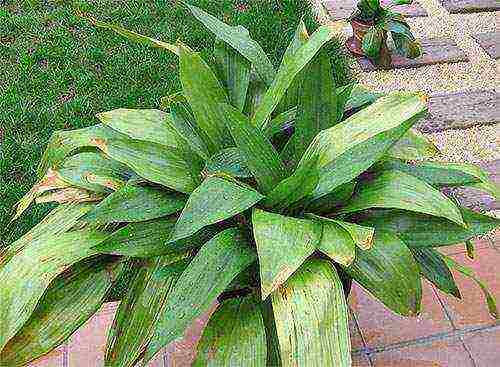 Aspidistra
Aspidistra
2. Aucuba
A semi-shrub, rarely found in home collections. Aucuba is a relative of the common cotoneaster and is just as unpretentious. Extremely shade-tolerant, in nature it lives where no other plants can withstand.
The cultivars have showy dark green leaves with yellow splashes. Aucuba can make an excellent office plant as dry, conditioned air is good for it.
 Aucuba
Aucuba
3. Aglaonema
Large leaves are decorated with silvery veins and are always turned towards the light. Aglaonema will grow in the depths of the northern room, while looking bright and stylish. The plant is thermophilic and demanding on the soil, does not tolerate drafts. Aglaonema is recommended to grow for 5-7 years, and then change, propagating with an apical cuttings. The plant is suitable for the kitchen, as it absorbs toxins released during the operation of heating equipment (vapors of formaldehyde, benzene, etc.).
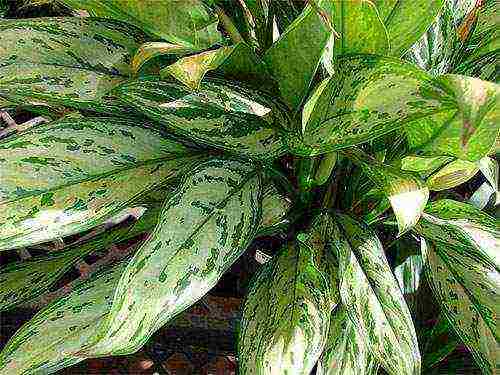 Aglaonema
Aglaonema
4. Sansevieria
The pike tail, aka Mother-in-law's tongue, was very popular in Soviet institutions. Sansevieria (sansevieria) will grow where it was placed - in deep shade or in the sun, she doesn’t care about tobacco smoke and drafts. In good conditions, it grows quickly and forms a dense "palisade"; when the soil is depleted, growth slows down and almost completely stops. Sansevier is a Spartan among indoor flowers, and looks accordingly - strict lines and "camouflage" colors.
In home flower beds, it is rarely found in our time - apparently because of the ascetic appearance. However, breeders have developed many new varieties of sansevier that deserve attention. It will be interesting to look at a group of sansevierias of different types - classic high ones together with rosette, compact and variegated ones. A pike tail with cylindrical leaves looks exotic. The latest fashion trend is a cylinder sansevier, braided into a braid.
 Sansevieria
Sansevieria
5. Scindapsus
He will willingly master the space under the ceiling. In nature, scindapsus is a creeping plant; domestic species are tied to a support, like a liana. It grows in length up to 5 meters or more. Lack of lighting for the skindapsus is not a problem. He loves warm air and cannot stand drafts.
The plant requires light, fertile soil and fertilization once a month. Like many members of the aroid family, scindapsus is poisonous. Therefore, it is advisable to place the plant in a place where children and pets cannot reach it.
The most spectacular are the variegated forms of golden scindapsus, with yellow and white strokes. The lack of light does not compromise the color of the leaves. Scindapsus can live for a long time, 20 or more years.
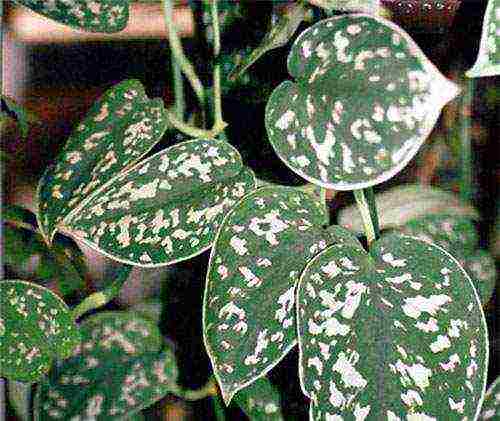 Scindapsus
Scindapsus
6. Ferns
In nature, ferns live under the canopy of dense forests, in a humid environment. Domestic ferns love shade and partial shade, light slightly acidic soils and moist air. Plants with graceful feathery frond leaves will fit into any design.
Traditionally, the fern is considered an office plant.In a small apartment, sprawling nephrolepis will take up too much space, but there are also compact species of ferns. For example, maidenhair, aka Venus of hair, is an excellent ampelous plant with a flowing lace of small leaves. Delicate maidenhair leaves cannot stand the sun even in small doses.
Ferns are quite demanding on air and soil moisture. In dry air, their "feathers" become coarse, covered with brown spots and eventually die off. The soil under the fern can be covered with a layer of moss - it will protect the ground from drying out, and the appearance of the plant will become more original. Ferns do not have a dormant period and prefer an even temperature and the same care throughout the year.
Like the reeds, the fern is considered a plant with dubious bioenergy. However, more often everything is explained more simply - an allergy to fern spores, as well as to reed fluff, is not uncommon.
 Fern
Fern
7. Zamioculcas, dollar tree
Beautiful in itself. Among other plants, the graceful contours of the zamiokulkas are lost. In addition, the flower is distinguished by its quarrelsome character: it either oppresses the neighbors of other species, or withers itself. It takes out only representatives of its own species and some palms (bokarney, chamedorea). Therefore, it is best to allocate an individual space for the dollar tree. By the way, the same is recommended by feng shui.
According to the signs, a pair of the same age zamiokulkas in identical pots on both sides of the door is a powerful talisman that attracts wealth. Signs are signs, but the fact that this is an original interior detail is one hundred percent true.
It is recommended to wipe the glossy leaves of the dollar tree more often - the brighter they shine, the stronger their "money-making" effect. The plant has nothing against removing dust from the leaves, it is good for it.
Zamioculcas can hardly be called a shade-loving plant. He prefers bright diffused light, but firmly tolerates the shadow, only slowing down growth. If you want to grow a large specimen of zamiokulkas, it is advisable to place it no more than two meters from the window, or organize a "rotational method", changing plants once a month.
When moving, it is not recommended to rotate the plants relative to the cardinal points. In order not to accidentally turn the pot "the wrong side", it is better to designate the northern direction on it in advance.
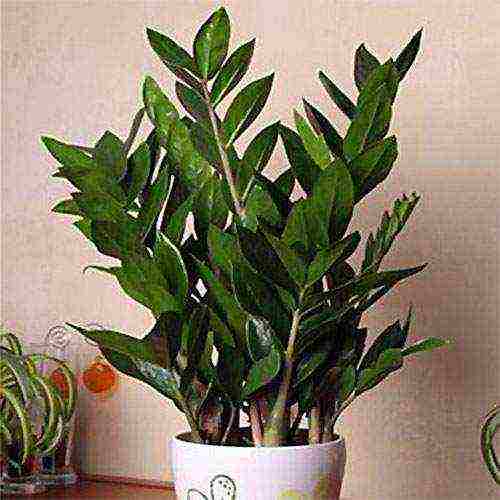 Zamioculcas
Zamioculcas
8. Anthurium
Majestic is the name of one of the types of indoor anthurium. Anthuriums look very solid and can decorate the office of a serious leader or the hall of a large company. So that the original round leaves do not lose their decorative effect, anthurium must be fertilized in a timely manner with a complex for variegated plants.
If the anthurium is placed closer to the window, then it will bloom with spectacular flowers that have only one petal, but very large and bright.
Anthurium acquired the nickname "male happiness", since even among the ancient Greeks it was considered a talisman of masculinity. Among the plants there is also "female happiness" - the graceful spathiphyllum. Both "happiness" get along well side by side and complement each other.
Spathiphyllum is a fashionable plant that is still rare in homes and requires approximately the same conditions as anthurium. Spathiphyllum blooms with white flowers resembling calla lilies.
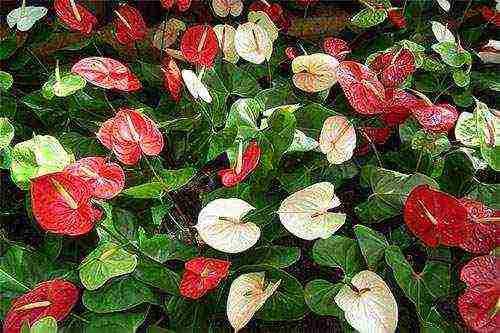 Anthurium
Anthurium
9. Poinsettia
The most beautiful spurge is not in vain awarded such a title. In Soviet times, poinsettia was called Scarlet Sails, and the name Christmas Star came from Europe. Poinsettia bracts are colored in different shades of red, from pink to deep purple, depending on the variety. There are forms with white and variegated "flowers", as well as double, reminiscent of roses. At home, the Mexican spurge reaches a height of three meters, but it tolerates pruning and formation in the form of a compact bush well.
You should carefully trim the poinsettia - the plant does not have a poisonous, but rather caustic juice.
The Christmas Star may well dwell at the northern windows in a cool (15-20 ° C) room.To get poinsettia blooming by Christmas, you should take care of artificially reducing daylight hours. From mid-November, during the month, the plant should be illuminated for no more than 12 hours a day. Artificial light is also undesirable - the flower can be covered with a dark bag or screen.
 Poinsettia
Poinsettia
10. Orchid
Nordic windowsills can be turned into orchid paradise. The butterfly flower, phalaenopsis is the most unpretentious of them. There are a great many varieties of phalaenopsis.
In the early stages, it is better to buy orchid substrate in the store. Special fertilizers are also sold there.
So that the orchids on the north window are not too dark, you can go for a little trick - attach mirrors on both sides of the window opening, for example, from an old dressing table, or foil. A homemade reflector will at least double the amount of scattered light.
Blooming phalaenopsis can delight not only their owners. Recently, it is very fashionable to give fresh flowers in pots. A do-it-yourself orchid is a wonderful gift for any holiday.
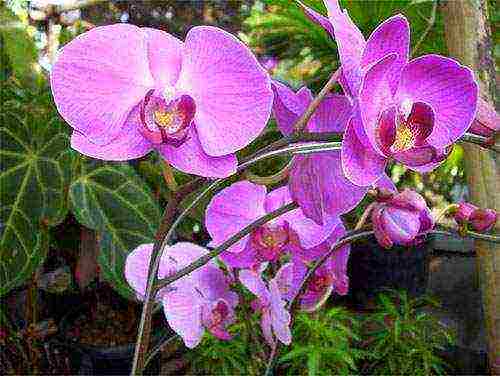 Orchid
Orchid
"Out of competition". About those plants that were not included in the list
Of course, there are not ten shade-tolerant plants, but much more. The above species are distinguished either by their particular unpretentiousness, like aspidistra or sansevier, or decorativeness, like poinsettia. A factor such as the fashion for indoor flowers should also be taken into account.
Plants with a thickened trunk are in trend today. Of the shade-tolerant ones, one can call the bent cycad, it is also the cicas - a plant with luxurious flowing feathery leaves. A large evergreen tree, reminiscent of a palm tree, but more squat. An ideal plant for hallways and spacious rooms. A spectacular cycad can be planted as a single plant or be the centerpiece of a group.
It is possible that in a few years hamedorea (bamboo palm) will be at the peak of popularity. This is the most shade-tolerant of the palms. It looks very elegant and is suitable for both the living room and the office.
As a rule, shade-loving plants have large dark leaves. For contrast, you can place a small-leaved selaginella (homemade lamb) or an unpretentious saltworm next to it. Forming a curly carpet, solirolium (gelksina) will look good as a ground cover plant in large pots.
Ficuses are timeless classics. Ficus and canary are the personification of a quiet and peaceful life in a small town of pre-revolutionary times. The Bengal ficus became the symbol of the family nest - planted once, it passed from generation to generation. In nature, ficuses live for 500 or more years, and at home - while there is someone to look after them.
Benjamin's ficus won the love and recognition of flower growers - the plant does not require special lighting and decorates any interior. And at the same time it cleans the air in the room, including the smell of tobacco. Ficuses are different - tree and ampelous, liana-like and dwarf. Through the efforts of breeders, variegated varieties of ficuses have been bred. Absolutely all ficuses are suitable for growing near northern windows.
Begonias do not need advertising - their decorative leafy forms can be found in almost every home and institution. If you want to diversify your collection, you can pay attention to new hybrids, which are produced annually in dozens and even hundreds.
Monstera is made for offices. Its bizarre leaves diversify the austere setting (and hide the solitaire monitor from the eyes of the bosses ...). It's so nice to enter from the summer heat into the gloomy and cool hall - and see there a fountain or micro-reservoir surrounded by monster thickets ...
Saintpaulias are very "home" plants, traditional inhabitants of northern windowsills. A child can also cope with breeding uzambar violets, and a huge number of varieties will save from monotony. The advantage of these plants is their compact size.If the apartment has a problem with free space, then Saintpaulia is the best candidate for the place of a pet.
***
Green pets living in the shade should be given attention and the lack of lighting should be compensated for with soil fertility, timely transplantation, fertilization and careful care. It is advisable to rearrange flowers in the back of the room for at least 2-3 months a year closer to the window - no matter how hardy the plant is, it still needs sunlight.
When we bring a plant into the house, we do not always think about whether the side of the world that our windows face is suitable for it. A spontaneous purchase, a gift from friends - and here we are with a pot in our hands, thinking where to attach a newcomer. And it does not always end well for the plant. Meanwhile, for any window there are numerous plants that will be comfortable in such conditions.

Well, if the windows in the house face different sides, then the question of a scrupulous choice is not worth it. The situation is worse if there is only one direction, and even then - north or north-west, where not every plant will survive. But even here there are a lot of different possibilities and options.
Plants for the north, north-east, north-west side

There is an opinion that it is difficult to find a beautiful flowering plant for windows in the northern direction. I hasten to assure you, this is a deep delusion. The north window is always diffused light; in winter there is some lack of daylight. Therefore, it is recommended to put flowering plants directly on the windowsill, and decorative plants that tolerate light shading well - near the window. Frequent residents of windows of northern directions becomeSaintpaulia (aka violet), hybrid begonia Lauren or Elatior, passionflower... Representatives of palm trees can quietly sit near the window:hovea, monstera... As well asficus, cineraria, fern, nightshade and many others.
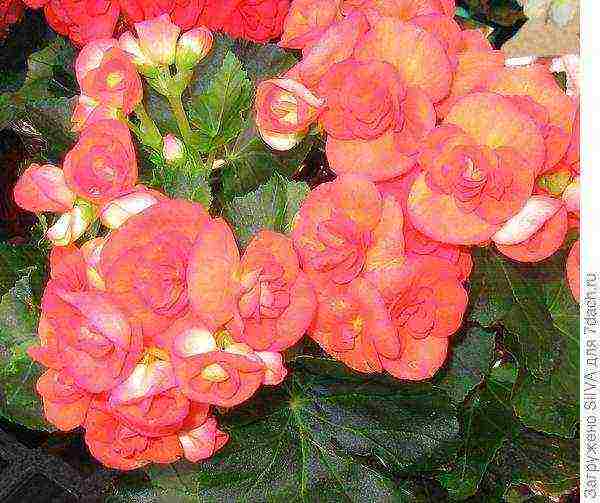
You can learn more about the best plants of the north, northeast, northwest side in the article "12 most popular plants for kitchen windows with a north, northeast and northwest direction."
Plants for the south side

When choosing a plant for the south window, it should be borne in mind that in summer the sun will be in abundance, and it will be scorching, therefore, plants that need diffused light will have to be shaded with a light tulle curtain or mosquito net. But in winter, during periods of lack of daylight, such windows will be a salvation for many plants. On windowsills with this direction, you can put the most resistant to heat and direct sunlight plants: cacti, succulents, hibiscus, adenium, passionflower, aloe tree... If the plant is photophilous, but direct sunlight is contraindicated for it, it can be placed near the window, and not on the windowsill. Plants, on the other hand, who love diffused light and a lot of heat, prefer windows in the south-west, east and even west.
Plants for the southwest side

A warm, southwestern direction with a delicate sun, turning into midday warmth and bright light, is well suited for plants with decorative colors or thermophilic cacti, succulents, and often vigorous flowering plants.
You can get acquainted in detail with the most popular representatives of the windowsills of the south-west side in the article "16 most popular plants for windows in the south-west, east and west for the kitchen." The difference between kitchen windows and room windows of the same direction lies in a higher temperature and increased humidity. But many of the plants for the kitchen can live comfortably in the living room or bedroom.
Southwest love: dieffenbachia, for which light is a guarantee of decorative leaves, azalea, begonia, anthurium, balsam, zebrina, chlorophytum, hoya, chrysanthemum, sansevieria... For flowering plants, light is a factor in the successful establishment of flower buds.
Plants for the west side
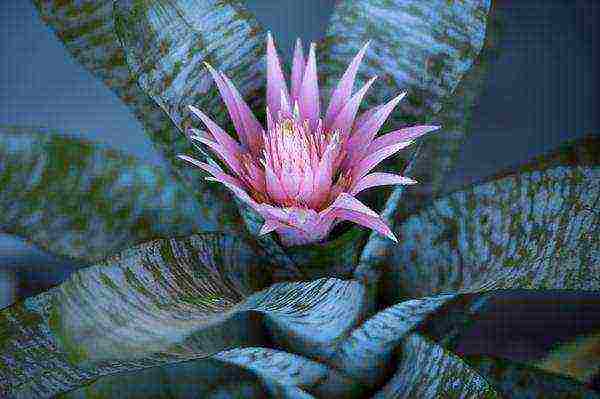
The windows on the west side are somewhat warmer than the windows on the east. On the western windowsills, plants that can fade or get burned, as well as those who like ambient light, shade. You can put here asparagus, jasmine low, cissus, hamerope, sansevieria, dizygoteku, eucalyptus, date palm, echmea, Rex begonia, wilted bilbergia... These plants thrive on the windowsill.
When placing plants a little further from the window, you should consider whether they will receive enough diffused light. In close enough proximity to the windows in the western direction in the space, the rooms can feel great azalea, anthurium, spathiphyllum, dizigoteca, bromelets, asparagus, cyclamen, shefflera, philodendron, chlorophytum.
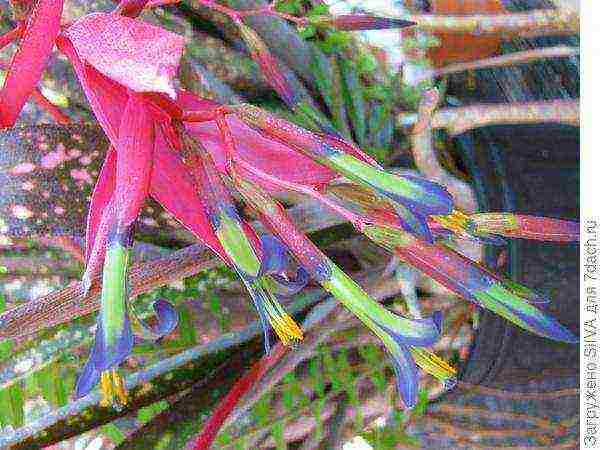
Plants for the east side
The windows in this direction are much less illuminated than the southern ones. In the morning, when the sun is just rising, its rays are not so scorching, so the plants will not have to be shaded and worried about possible leaf burns. Oriental windows were chosen
narrow-leaved and deremenian dracaena, asparagus, ficus, uzambara violet, ivy, myrtle, aucuba .
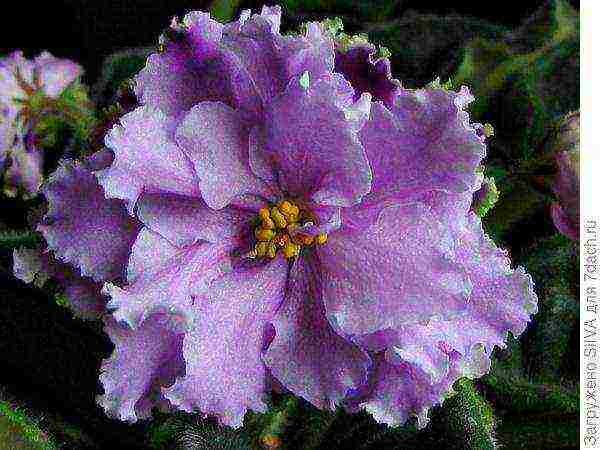
So, if a new plant has appeared in your house, now you know where it is better to put it, and if you are just thinking about purchasing a new green pet, use the information provided to understand whether it will feel good on your windows.
From the administration: we are running a home flower contest with great prizes from the Hoff online store. Upload photos of home flowers and get prizes.
